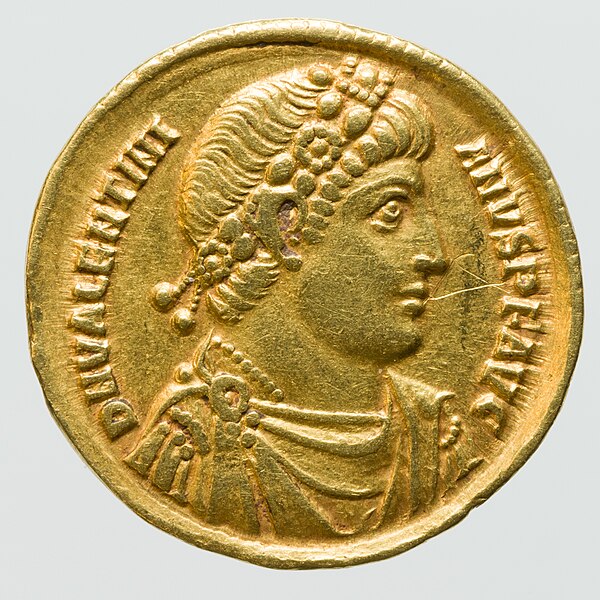The solidus or nomisma was a highly pure gold coin issued in the Later Roman Empire and Byzantine Empire. The early 4th century saw the solidus introduced in mintage as a successor to the aureus, which was permanently replaced thereafter by the new coin, whose weight of about 4.5 grams remained relatively constant for seven centuries.
Solidus of Theodosius II, minted in Constantinople c. 435. This design of the emperor with the spear over his shoulder was the conventional portrait for over a century in the Eastern Roman Empire, from AD 395 to 537
Solidus of Constantine the Great, minted in AD 324 or 325
Solidus of Constantius II from Antioch, 347–355. A holed coin such as this was likely worn as a jewelry piece by a prominent or wealthy Roman
Light-weight solidus of 22 siliquae minted by emperor Tiberius Constantine at Antioch in Syria, c. 580. The light-weight solidi were minted from c. 550–650 and were primarily used for foreign trade with Europe.
A gold coin is a coin that is made mostly or entirely of gold. Most gold coins minted since 1800 are 90–92% gold (22‑karat), while most of today's gold bullion coins are pure gold, such as the Britannia, Canadian Maple Leaf, and American Buffalo. Alloyed gold coins, like the American Gold Eagle and South African Krugerrand, are typically 91.7% gold by weight, with the remainder being silver and copper.
Gold coins for sale at the Dubai Gold Souk
Persian Achaemenid Daric, c. 490 BC
Gold Solidus of Roman Emperor Valentinian II
A 20-crown gold coin from Norway. Introduced in 1875, it became part of the Scandinavian Monetary Union, which was based on a gold standard. Norwegian gold reserves included tonnes of this and other coins, backing Norway's paper money. The coin was designed for circulation: "124 Stk. 1 Kil. f. G." means that 124 pieces gave one kilogram of pure gold.








